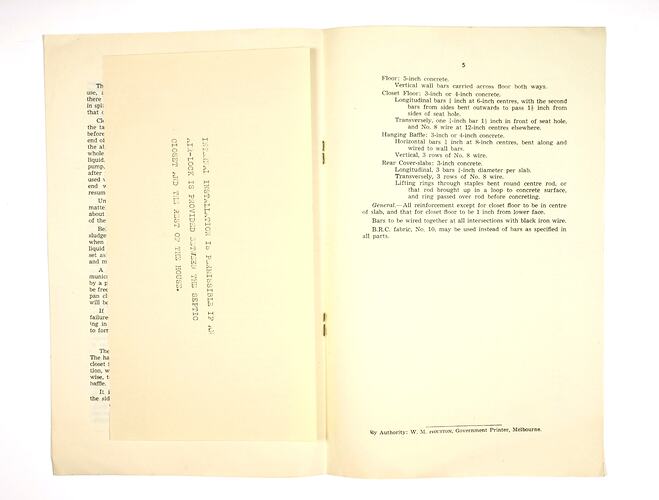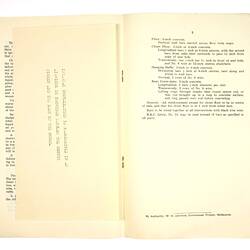Summary
Booklet entitled 'Design For A Septic Closet', by E.A. Hepburn, B.C.E., A.M.I.C.E., published by the Commission of Public Health Victoria, 1953. Printed by W.M. Houston, Government Printer, Melbourne. (2 copies)
The text describes the design, installation and operation of a modified septic tank system suitable for "householders outside the sewed areas, and particularly those not served by a municipal sanitary service", such as "the farmer, or dweller in a small township who is dependent on roof catchment for his water supply". The design, which originated from Lumsden, Roberts and Stiles of the United States Public Health Service, was later further developed by Dr Joseph Nathaniel McCormack (1847-1922) of the Kentucky State Board of Health and widely promoted throughout rural America during the early decades of the 20th century as the 'Kentucky Sanitary Privy'. It consisted of a liquefying in-ground septic sewage treatment tank with one end directly under a closet seat similar to that used for a standard sanitary pan closet toilet. Treated effluent from the outer section of the tank was discharged into a terracotta agricultural drain pipe buried beneath soil and gravel at the bottom of a trench 12 to 18 inches deep. The advantage of the design was that it required less water to operate than a conventional septic tank. On page 2 there is a line drawing showing cross-section and plan views of the proposed "Septic Closet", signed "J & W Donnell, 17-11-52".
Pan closets with regular nightsoil collection had been the preferred method of sewage disposal for remote properties and unsewered towns or urban areas in Victoria from the late 19th century, but over the decades growing concern developed over the nuisance that they created by generating offensive smells, attracting flies and risk to public health through poor sanitation. In Melbourne although an underground sewerage system had been built during the 1890s, with the first properties connected in 1897, the Melbourne & Metropolitan Board of Works (MMBW) struggled to expand the sewer network fast enough to keep up with the city's rapid growth. A Royal Commission on Sewerage in 1926 recommended improvements to the methods for disposing of nightsoil from unsewered areas. Subsequently the Engineer of Sewerage for the MMBW was sent to Adelaide with members of the Sewerage Commission to investigate the use of septic tanks for individual properties. A recommendation was made for the government to prepare legalisation compelling the installation of septic tanks for unsewered properties but little was done.
As Melbourne's post-World War II housing boom gathered momentum the backlog in sewerage connections continued to grow, particularly in the sprawling new eastern and south-eastern suburbs which lay outside the natural catchment area of the Werribee Sewerage Treatment Plant on the western shores of Port Phillip Bay. In 1929, a 1,157-acre property had been acquired by the MMBW at Mordialloc to develop a second treatment facility but there was strong local opposition to the plan and it would take time to build the necessary infrastructure of new sewers. By 1963, there were 117,000 unsewered properties in the Melbourne Metropolitan area, of which 38,000 relied on septic tanks, and a decade later there were 80,500 septic tanks. Poorly maintained and wrongly installed septic tanks combined with the inherent nature of Melbourne's clayey soils, which did not readily absorb septic tank effluent, to create a growing nuisance. Slowly and reluctantly Melburnians came to accept the it was the sullage and seepage from their septic tanks that was fouling the city's waterways and beaches.
Finally through the Whitlam Government's National Sewerage Project, Federal funds were provided to the MMBW, enabling it to finally complete the South Eastern Purification Plant in 1975 and the South Eastern Trunk Sewer which ran from Kew to Carrum enabling many of the suburbs previously dependant on septic tanks to be sewered.
Physical Description
Staple-bound 8-page booklet printed in black ink on off-white paper stock.
More Information
-
Collecting Areas
-
Acquisition Information
Donation from J. Flack, 29 Jan 2010
-
Author
Mr E. A. Hepburn B.C.E., A.M.I.C.E. - Commission of Public Health, Victoria, Melbourne, Victoria, Australia, circa 1952
-
Publisher
Department of Health, Victoria, Commission of Public Health, Melbourne, Victoria, Australia, 1953
-
Printer
W.M. Houston, Government Printer, Melbourne, Victoria, Australia, 1953
-
Inscriptions
Text, printed front page: 'COMMISSION OF PUBLIC HEALTH VICTORIA/DESIGN FOR A SEPTIC CLOSET/by E.A. Hepburn, B.C.E., A.M.I.C.E. '57681/53' code printed near bottom left-hand corner of front page.
-
Classification
-
Category
-
Discipline
-
Type of item
-
Overall Dimensions
154 mm (Width), 242 mm (Height)
-
Keywords
Public Health, Sanitary Engineering, Sanitary Pans, Sanitation, Septic Tanks, Sewage Disposal

